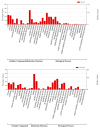Gill Transcriptome Sequencing and De Novo Annotation of Acanthogobius ommaturus in Response to Salinity Stress
- PMID: 32521805
- PMCID: PMC7349121
- DOI: 10.3390/genes11060631
Gill Transcriptome Sequencing and De Novo Annotation of Acanthogobius ommaturus in Response to Salinity Stress
Abstract
Acanthogobius ommaturus is a euryhaline fish widely distributed in coastal, bay and estuarine areas, showing a strong tolerance to salinity. In order to understand the mechanism of adaptation to salinity stress, RNA-seq was used to compare the transcriptome responses of Acanthogobius ommaturus to the changes of salinity. Four salinity gradients, 0 psu, 15 psu (control), 30 psu and 45 psu were set to conduct the experiment. In total, 131,225 unigenes were obtained from the gill tissue of A. ommaturus using the Illumina HiSeq 2000 platform (San Diego, USA). Compared with the gene expression profile of the control group, 572 differentially expressed genes (DEGs) were screened, with 150 at 0 psu, 170 at 30 psu, and 252 at 45 psu. Additionally, among these DEGs, Gene Ontology (GO) analysis indicated that binding, metabolic processes and cellular processes were significantly enriched. Kyoto Encyclopedia of Genes and Genomes (KEGG) pathways analysis detected 3, 5 and 8 pathways related to signal transduction, metabolism, digestive and endocrine systems at 0 psu, 30 psu and 45 psu, respectively. Based on GO enrichment analysis and manual literature searches, the results of the present study indicated that A. ommaturus mainly responded to energy metabolism, ion transport and signal transduction to resist the damage caused by salinity stress. Eight DEGs were randomly selected for further validation by quantitative real-time PCR (qRT-PCR) and the results were consistent with the RNA-seq data.
Keywords: Acanthogobius ommaturus; RNA-seq; differentially expressed genes (DEGs); salinity stress.
Conflict of interest statement
The authors declare no conflict of interest.
Figures






Similar articles
-
Characterization and analysis of transcriptome complexity using SMRT-Seq combined with RNA-Seq for a better understanding of Acanthogobius ommaturus in response to temperature stress.Int J Biol Macromol. 2021 Dec 15;193(Pt B):1551-1561. doi: 10.1016/j.ijbiomac.2021.10.218. Epub 2021 Nov 3. Int J Biol Macromol. 2021. PMID: 34742843
-
Transcriptomic analysis reveal an efficient osmoregulatory system in Siberian sturgeon Acipenser baeri in response to salinity stress.Sci Rep. 2018 Sep 25;8(1):14353. doi: 10.1038/s41598-018-32771-x. Sci Rep. 2018. PMID: 30254302 Free PMC article.
-
Identification of differentially expressed genes in gills of tiger puffer (Takifugu rubripes) in response to low-salinity stress.Comp Biochem Physiol B Biochem Mol Biol. 2020 Jun;243-244:110437. doi: 10.1016/j.cbpb.2020.110437. Epub 2020 Apr 1. Comp Biochem Physiol B Biochem Mol Biol. 2020. PMID: 32247057
-
RNA-seq analyses of Marine Medaka (Oryzias melastigma) reveals salinity responsive transcriptomes in the gills and livers.Aquat Toxicol. 2021 Nov;240:105970. doi: 10.1016/j.aquatox.2021.105970. Epub 2021 Sep 16. Aquat Toxicol. 2021. PMID: 34562875
-
Transcriptome analysis of starch and sucrose metabolism across bulb development in Sagittaria sagittifolia.Gene. 2018 Apr 5;649:99-112. doi: 10.1016/j.gene.2018.01.075. Epub 2018 Jan 31. Gene. 2018. PMID: 29374598 Review.
Cited by
-
Transcriptome Profiling Reveals a Divergent Adaptive Response to Hyper- and Hypo-Salinity in the Yellow Drum, Nibea albiflora.Animals (Basel). 2021 Jul 25;11(8):2201. doi: 10.3390/ani11082201. Animals (Basel). 2021. PMID: 34438658 Free PMC article.
-
RNA Sequencing Analysis Reveals Divergent Adaptive Response to Hypo- and Hyper-Salinity in Greater Amberjack (Seriola dumerili) Juveniles.Animals (Basel). 2022 Jan 29;12(3):327. doi: 10.3390/ani12030327. Animals (Basel). 2022. PMID: 35158652 Free PMC article.
-
Transcriptome and molecular regulatory mechanisms analysis of gills in the black tiger shrimp Penaeus monodon under chronic low-salinity stress.Front Physiol. 2023 Mar 1;14:1118341. doi: 10.3389/fphys.2023.1118341. eCollection 2023. Front Physiol. 2023. PMID: 36935747 Free PMC article.
-
De novo transcriptome assembly of the Perna viridis: A novel invertebrate model for ecotoxicological studies.Sci Data. 2025 Jan 25;12(1):147. doi: 10.1038/s41597-025-04496-w. Sci Data. 2025. PMID: 39863659 Free PMC article.
-
Field application of de novo transcriptomic analysis to evaluate the effects of sublethal freshwater salinization on Gasterosteus aculeatus in urban streams.PLoS One. 2024 Mar 13;19(3):e0298213. doi: 10.1371/journal.pone.0298213. eCollection 2024. PLoS One. 2024. PMID: 38478568 Free PMC article.
References
-
- Canovas C.G., Millan A., Velasco J., Vaughan I.P., Ormerod S.J. Contrasting effects of natural and anthropogenic stressors on beta diversity in river organisms. Glob. Ecol. Biogeogr. 2013;22:796–805. doi: 10.1111/geb.12060. - DOI
-
- Du Y., Zhang Y., Shi J. Relationship between sea surface salinity and ocean circulation and climate change. Sci. China Earth Sci. 2019;62:771–782. doi: 10.1007/s11430-018-9276-6. - DOI
-
- Charmantier G., Charmantier-Daures M. Ontogeny of osmoregulation in crustaceans: The embryonic phase. American zoologist. 2001;41:1078–1089. doi: 10.1093/icb/41.5.1078. - DOI
-
- Wang Y., Ye Z., Liu Q., Wang W., Cao L., Shen W. Otolith chemical signatures of spottedtail goby Synechogobius ommaturus in coastal waters of China. Chin. J. Oceanol. Limnol. 2011;29:640–646. doi: 10.1007/s00343-011-0125-4. - DOI
Publication types
MeSH terms
LinkOut - more resources
Full Text Sources

